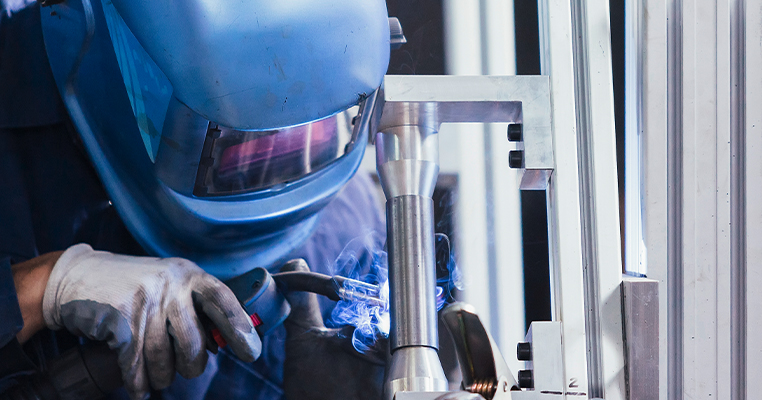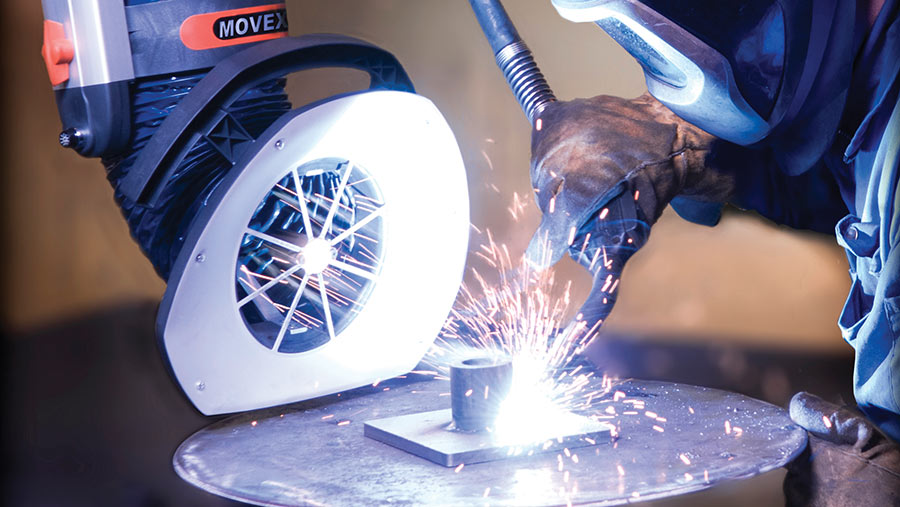Are you interested in welding on the farm? From welding fences to mending broken tools, it is an incredibly useful skill to have.
With this guide, you’ll be a master of the trade in no time! Learn the tips and techniques you need to know to begin welding safely and efficiently.
This guide is intended for the beginner or intermediate welder on the farm who desires an understanding of welding techniques, safety considerations, and a few tips for welding applications found on smaller operations. This comprehensive guide will cover everything from basic theory to proper equipment utilization and maintenance.
In addition to offering guidance and instruction on this important practical skill, this guide also offers substantial discussion of safety related topics associated with farm welding activities as well as several troubleshooting tips.
Whether you are new to the craft of welding or simply looking to sharpen your skills and gain more confidence in your abilities, this guide is designed to assist with that goal. While the primary focus of this manual is geared towards hobbyist welders on the farm—it should be understood that even experienced welders can benefit from continued learning opportunities. The following will provide supplemental information necessary for any level of welder.
Definition of welding on the farm
Welding on the farm is the process of connecting two or more metals using intense heat to melt them together. A skilled welder will be able to join pieces of metal in a variety of configurations or shapes with the correct material, joint design, and techniques. Welding techniques on the farm are employed in many applications throughout agriculture such as in equipment repairs, building construction, and livestock-handling operations.
Due to its impressive strength, welding is used for permanent joints that must last for years. When properly welded, joints have greater structural integrity than those produced with fasteners such as nuts and bolts that are also used in many farming applications. Advantages of welding on the farm include:
- 1. Greater Strength: Welded joints have greater strength than those produced with fasteners due to a superior bond between metals;
- 2. Design Flexibility: A skilled welder can create complex shapes and contours that cannot be obtained with traditional fastening methods;
- 3. Improved Safety: Because stronger bonds are created with welding there is less opportunity for pieces being joined coming apart;
- 4 Ensuring Proper Fitment: With welding thermostat’s piece must fit together perfectly before they can successfully be joined; this reduces leakage and other potential problems caused by poor fitment;
- 5 Cost Efficiency: Welding requires less time which leads to lower labour costs; and
- 6 Adhering to Regulations: Many regulatory codes require welding when it comes to certain safety processes making it necessary even if cost efficiency isn’t always a factor.

Importance of welding on the farm
Welding is a useful and versatile skill to have on any farm. It is an invaluable tool we can use to create, maintain and repair a wide range of farming equipment as well as structures. Not only can it offer significant savings in cost when compared to purchasing new parts, but it also provides more control over the shape, size and strength of your individual components. In addition, welding can make many jobs easier by making durable, lasting repairs with little effort.
Welding has many applications on a farm; everything from repairing machinery and equipment used in daily operations right up to building barns and custom steel structures. It is an effective way to make permanent repairs that are often stronger than the original structure or item being welded together. Not only can it be used for repairs but also for creating new projects like steel ramps or large storage tanks or building materials such as custom fabricated metal pipes and railings. We can even use welding techniques to maintain many parts over time which reduces the need for purchasing replacements in the future. This not only leads to monetary savings but also requires less maintenance time down the road when done correctly.
Techniques for Welding on the Farm
Welding on the farm is an important skill to have if you are looking to make repairs and additions to your machines. It can be intimidating at first, but with some practice, you can become a master welder in no time! Below, we provide some tips and techniques for welding on the farm that are easy to follow.
Before You Begin – Safety First!
Before attempting any welding tasks, it is important to take certain safety precautions for both you and anyone else in the vicinity. Be sure to wear proper safety gear such as a fire-resistant hat, gloves and clothing as well as eye protection. Make sure area has been cleared of any flammable material and that the work space is well ventilated. Take the time to read through the manufacturer’s instructions before beginning any welding task – these guidelines will help ensure that you complete your job properly and safely each time!
Types of Welds Commonly Used on Farms:
1. Arc Welding – This type of welding uses an electrical current between two electrodes that create a spark when they are touched together by hand or by a machine arm. The intense heat created by this spark melts both pieces of metal together forming a strong bond that won’t come apart easily once cooled. Arc welding is used for most farm applications due to its affordability, portability, strength and ease of use relative to other types of welds.
2. TIG Welding (Tungsten-Inert Gas) – TIG welding utilizes an arc between a non-consumable tungsten electrode and the workpiece while feeding in an inert gas such as argon or helium to protect it from contamination as well as creating consistent results every time. Because this type of weld requires precise control on behalf of the operator, it is usually reserved more difficult tasks such as thin metalwork or intricate detailing where accuracy matters most.
3. MIG Welding (Metal Inert Gas) – Using Automated Metal Transfer (AMT), MIG welding feeds filler material into arcs created by electric current passing through wire spooled from a tube mounted above it onto two metals thanks its self-shielding nature which increases speed tremendously for extended weld runs vs TIG or stick methods– perfect for all straight line linear welds needed on large scale farm machinery & equipment projects.
Repairing metal fences
When it comes to welding on the farm, one of the most common tasks is repairing metal fences. Metal fences are a long-lasting and cost effective option for farmers and ranchers but will eventually require some form of maintenance or repair. The following steps will guide you through repairing metal fences with a welder:
- Inspect the damaged area to identify the extent of the problem.
- Cut out any broken or rusted sections with a cutting torch or angle grinder, taking control m to make sure that only what needs to be cut away is removed.
- Measure and mark up replacement sections of metal, making sure that they suitably match up and cover what has been cut away.
- Using minimal heat settings and low amperage, slowly build up layers of weld on both sides of each joint beginning at the center line and working outwards on both plates in order to avoid warping that comes with excessive heat levels.
- Use either grinding wheels or wire brushes to clean away any excess spatter or flux from completed welds and surrounding areas before applying sealant if necessary for added protection from moisture or rusting in the future.
Building gates and livestock pens
Creating fences, gates and pens are essential tasks on any farm. Whether you’re building new structures from scratch or repairing existing ones, welding is the best tool for the job. We will discuss a few different techniques to help you get started with welding on the farm.
One of the most common types of welding for gates and livestock pens is stick welding. This type of welding uses an alternating current (AC) arc supplied through a rod that has been coated in flux to protect the weld from contamination. Stick welding can work with a wide variety of metals, including steel and aluminum, but it must be protected from windy conditions by being done in shady areas or inside a protected area away from drafts or gusts that could blow dirt into the weld pool. The rods come in various diameters and usually require consistent motion while moving along an inch and small circles to achieve good coverage over large areas.
TIG welding is another best option when it comes to building gates and livestock pens due to its precision and effectiveness with thin gauge materials. It involves creating an electric arc between two pieces of metal while using a non-consumable tungsten electrode immersed into melted metal filler materials that are added as needed during the operation. TIG provides superior control when compared to other forms of welding, allowing even novice welders create clean beads at lower current settings than other processes used for livestock equipment fabrication like MIG and flux-core bonding. Its greater thermal efficiency is also ideal for tight joints where higher speeds might be needed when having limited access room because it allows finer puddle control which reduces slag attachment problems from occurring near the edges of parts we’re joining together when making compound angles on frames or curved pieces like archway style gates.
Safety Precautions
When it comes to welding on the farm, safety should be the number one priority. Whether you’re just learning or have been welding for years, ensuring your safety is key to preventing injury and damaged equipment. To ensure a safe welding environment, keep these tips and techniques in mind.
- Inspect Your Equipment Before Use – Always inspect all equipment before use: including torch nozzles, hoses, clamps, hangers, electrodes and tips for any wear or damage.
- Wear Proper Protection – Wear long sleeves and pants made of fire retardant materials like leather or denim and a welding helmet certified to comply with ANSI Z87.1-2003 standards to protect your eyes from the intense light of the arc welds. Face shields are also recommended during Melt Welding Gas Shielded Processes and when working with highly hazardous sparks and splatter such as aluminum welding processes; such as Mix (MIG/MAG) Welding Gas Shielded processes that require flux cored wire electrodes and hot wire feeding systems. Use heavy leather gloves when working around hot metal surfaces like tanks and pipes to avoid burns.
- Always Ground Yourself to Reduce Risk of Electric Shock – Make sure any exposed metal is securely grounded prior starting operations; this includes the welder itself as well as any work surface where you will be laying out pieces of metal while you weld them together instantly reducing risk of electric shock which can be life-threateningly dangerous should the operator come into contact with any live electric current. Never fail to take these essential steps!
- Limit Exposure Time Whenever Possible & Take Regular Breaks – Since welders are exposed to extreme levels of light when they work with flame plumes from combustion during operations – limit your exposure time by taking regular breaks every half an hour or so whenever possible or higher if needed. Even short exposure can cause harm overtime (UV burn) if not taken seriously.
- Preheat Work Surface(s) Beforehand Where Necessary – Preheating work surfaces ensures that less heat is required for joining metals during operations improving speed heightening quality of results & extending life span of tools & consumable parts used by welder while also reducing stress applied onto O-rings seals hoses clamps& other components being operated upon thus reducing risk causing equipment breakage downline saving time money & effort in unfortunate reparation repair events that might occur shortly thereafter due result negligence!
Protecting yourself from harmful fumes
- Protecting yourself from harmful fumes is essential when welding on the farm as inhalation of these dangerous particles can cause significant respiratory issues, damage to the brain, and other serious health complications. To reduce the risk of injury, always make sure to work in a well-ventilated area, wear a protective breathing mask, and properly maintain all safety equipment. When welding for long periods of time or during multiple days, be sure to take breaks to give your lungs time to rest from inhaling smoke and other fumes.
Additionally, you should never weld without gloves and a flame-resistant jacket or body suit made with special heat-resistant fabrics that allow the heat generated by welding machines to dissipate. In some environments, it’s also wise to wear dark glasses or a helmet with an eye shield in order to prevent glare and reduce the risk of burnt retinas.
Finally, consider checking with your local fire safety department for any special precautions that might need to be taken in order to comply with regulations pertaining to safe work practices.
Proper ventilation
When welding, it is essential to provide proper ventilation and exhaust to ensure that any hazardous vapors are pulled away from welders and bystanders. Make sure you are in an adequately ventilated area with a steady supply of fresh air and restrict the number of people who can observe the operation at any given time.
Additionally, if possible use floor or table-mounted enclosed fume extractors with proper air filters in areas with poor ventilation. Fumes should never be allowed to linger inside a building or enclosed space, as they can irritate eyes, throat, nose and lungs.

Safe welding practices
Conducting safe welding on the farm requires a commitment from everyone in the vicinity. Understanding and following a few basic safety rules and best practices will help ensure an accident-free work environment.
Prior to doing any welding on your farm, conduct a thorough inspection of the work area. Remove any combustible materials, such as paper and wood, that might catch fire due to sparks or ultraviolet rays emitted during welding. Also check around the station for gas lines or electrical wiring that could be problems if welders fail to follow safety precautions. Wear the proper protective gear and clothing when welding: leather gloves, long pants and closed shoes with steel toes. A welder’s mask should be worn at all times when welding in order to protect your eyes from the intense heat generated by oxyacetylene torches, arc welders or TIG welders. Make sure there is adequate ventilation for hazardous fumes generated by some welders or processes, such as galvanizing or spot-welding galvanized metals like sheet metal and steel decking boards.
It’s also important to use correct techniques when performing maintenance and repairs on your farm equipment with welding equipment:
- Do not attempt unwarranted repairs while working on machines unless they are trained mechanics.
- Never modify existing mechanisms without consulting certified personnel familiar with the machine’s design specifications
- Always adhere strictly to operation instructions enclosed with any piece of equipment you may use that contains potentially hazardous moving parts, such as air compressors, generators or other motorized pieces of equipment
- Never operate any machine without first receiving instruction from a qualified instructor about its operation.
Maintenance and Repair
Proper maintenance for welding tools is essential for safe and efficient operation. Neglected equipment can fail without warning and cause injury or death. Regularly inspecting and testing your welding equipment, as recommended by the manufacturer, will help ensure optimal performance and safety.
It is also important to remember that the overall integrity of an object welded together from many pieces depends on the correctness of each piece being joined together in the weld. Common causes of incorrect joints may include gaps between parts, slag trapped in the joint area, or chemical contamination caused by oils or rust. Thorough pre-weld inspection and proper preparation techniques can help minimize problems with faulty welding joints and will make repair easier if needed.
Many farmers have gained experience in basic fabrication work like repairing broken structural members or fabricating practical machine guards over time. When such repairs occur close to welding operations, it is important to manage factors such as sparks or hot metal fragments flying onto other areas or nearby combustible materials. For example, if a farmer repairs a piece of farm machinery using arc welding then he should ensure that there are no combustible materials around which may catch fire from sparks generated from the arc welding process. By taking proper precautions, farm personnel can protect themselves as well as their property from damage resulting from unexpected incidents due to poor preparation for a welding job.
Cleaning and maintaining welding equipment
Before you start to weld, it is important to thoroughly clean and maintain your equipment. This helps prevent welding defects and premature wear on the machinery, as well as ensure a quality weld for all of your projects.
To properly clean and maintain your welding equipment, follow these steps:
- Wear protective clothing when cleaning and maintaining the equipment, such as eye protection and flame-retardant heat resistant gloves.
- Disconnect the power supply from the main power source before attempting any maintenance or cleaning tasks.
- Protect enclosed areas from contact with liquids or debris by covering them with plastic sheeting or plastic bags secured with tape prior to anything being sprayed or blown into them.
- Brush over surfaces to be cleaned using an approved brush designed for use with the specific metals you are working on; use an additional soft brush in corners, edges and other hard-to-reach places where buildup may occur over time due to dust, grease and other particles accumulating in these areas of concentrated use.
- Remove any dirt or rust accumulated on metal surfaces using a mild abrasive cleaner applied either by hand or through a pressure washer; make sure to rinse thoroughly afterwards as residual detergent can cause corrosion if left behind.
- Apply lubricant to hinges, moving parts and other connections after rinsing away any dirt that had accumulated around them so they will not be damaged during operation of the machine due to friction from dirt buildup between components that are disjointed from proper lubrication maintenance throughout regular use of the equipment over time – taking this step helps keep everything working smoothly!
Repairing damaged welding equipment
Repairing your welding equipment is an important part of working with metals on the farm. In order to get the job done correctly, it’s important to have well-maintained components. Faulty welding equipment can lead to costly repairs or dangerous accidents.
Here are some tips and techniques for repairing damaged welding equipment:
- Regularly inspect your welding machine’s components and cords. Look for frayed wires, cracked or worn insulation, or any other damage that could cause a failure during a weld.
- Whenever possible, replace damaged parts rather than attempting to repair them. This will ensure greater safety when operating the machine and may extend the life of the equipment.
- Follow manufacturer’s instructions for cleaning and storing all parts associated with your welding machine. Make sure all cylinders are kept in a secure dry place and are not exposed to extreme temperatures, moisture or dust—which can cause corrosion or damage to vital components of the machine.
- Replace consumable parts such as nozzles, electrodes and liners when worn or damaged beyond repair points recommended by the manufacturer—this will help ensure safe operation of your machine over time and prevent problems from occurring down the road due to nonfunctional parts.
- Consider investing in protective gear, such as gloves and face masks—these should be used during all phases of welding operations in order to guard against hazardous materials that may be produced while repairing damaged welding equipment.

Conclusion
The use of welding on a farm has become increasingly essential in the modern world. It allows farmers to have increased flexibility, safety and efficiency on their farms. However, it is important to understand all the basics before attempting any welding job.
There are different types of welders available, and it is very important to match the right type of welder with the task at hand. Additionally, there are a variety of different techniques for successful welding jobs, and it is important for farmers to understand and use safe welding practices.
With increased understanding, skill development and practice, farmers can confidently undertake any welding project needed on their farm.
FAQ
What are the 7 basic welding techniques?
The 7 basic welding techniques are MIG welding, TIG welding, Stick welding, Flux-cored welding, Submerged arc welding, Plasma arc welding, and Gas welding.
What are the 4 techniques of welding?
The 4 techniques of welding are Gas welding, Arc welding, Resistance welding, and Energy beam welding.
What type of welding is best for farm use?
MIG welding is considered the best type of welding for farm use due to its versatility and ease of use.
What are the 11 helpful tips in welding?
The 11 helpful tips in welding are: choosing the right welding technique, selecting the right welding equipment, preparing the metal surface, using the right welding wire or electrode, maintaining the correct welding angle, controlling the heat input, avoiding overheating, using proper safety gear, practicing good welding technique, inspecting the welds, and seeking professional help when needed.
What is farm welding?
Farm welding refers to the process of welding metal components used in agricultural machinery, equipment, and structures.
How is welding used in agriculture?
Welding is used in agriculture to repair and maintain farm equipment, construct buildings and structures, and fabricate custom parts and components.
What is the 5 steps in welding?
The 5 steps in welding are: cleaning the metal surface, setting up the welding equipment, positioning the metal pieces, welding the joint, and inspecting the weld.
What are the 5 basic weld types?
The 5 basic weld types are Butt joint, Corner joint, Lap joint, T-joint, and Edge joint.
What are 2 of the most common welding techniques?
The two most common welding techniques are MIG welding and Stick welding.
What are the rules of welding?
The rules of welding include selecting the right welding technique, using the correct welding equipment, preparing the metal surface, controlling the heat input, avoiding overheating, using proper safety gear, practicing good welding technique, inspecting the welds, and seeking professional help when needed.
See Also :
- Best incubator for duck eggs 2023
- Best barbed wire for cattle 2023
- Best milkhouse heater 2023
- Best cattle ear tags 2023
- Best rotary tiller for tractor 2023


